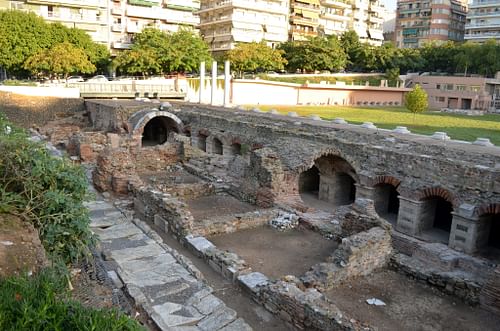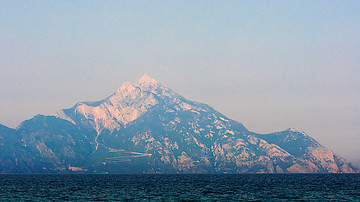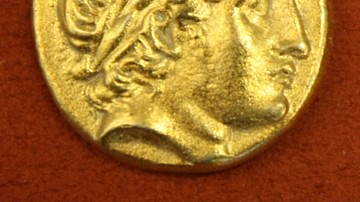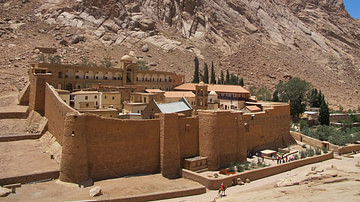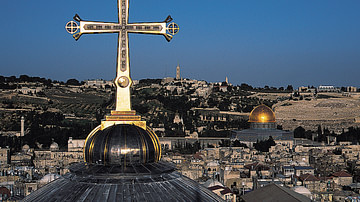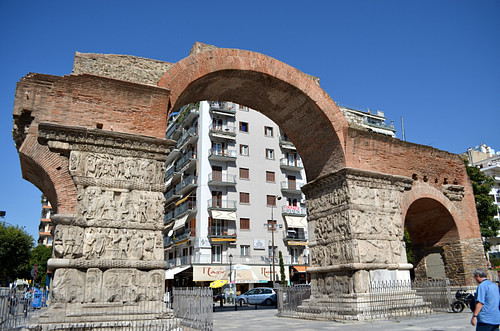
Thessalonica (also Thessalonike) was an ancient city of Macedon in northern Greece which today is the city of Thessaloniki. Made capital of the Roman province of Macedon, the city flourished due to its location on the major trade route to the east and continued to thrive as one of the most important cities in the Byzantine Empire. Its prosperity and cultural reputation attracted such figures as Paul the Apostle, Roman emperor Galerius, Cicero, and Lucian over the centuries. Substantial archaeological remains have been excavated and a Roman triumphal arch still stands as one of the city's most famous landmarks. Thessalonica is listed by UNESCO as a World Heritage Site.
Historical Overview
Traditionally Thessalonica was founded in c. 316 BCE by the Macedonian general Cassander who named it after his wife Thessalonike, daughter of Philip II of Macedon. However, there is archaeological evidence of a settlement dating back to the 5th century BCE and Cassander is known to have abolished previous settlements in order to unify them into the single political unit of Thessalonica. The city was well-positioned on the Thermaic Gulf of the Aegean at the point where lucrative trade routes from Byzantium and the Danube basin met. It quickly replaced Pella as the most important Macedonian port, and extensive fortifications were built to protect the city. It was used effectively as a military base from which attacks were launched on Pyrrhus, King of Epirus, c. 273 BCE.
Although the city successfully resisted a prolonged Roman siege during the Macedonian Wars, it was taken over following the general Macedonian defeat at the battle of Pydna in 168 BCE. There, in the Third Macedonian War, Lucius Aemilius Paullus defeated an army led by king Perseus which gave the Romans control of Macedon and ended its monarchy. Thessalonica was made the capital of the new Roman province of Macedon in 148 BCE and benefitted from the construction of the via Egnatia in c. 130 BCE which was the Romans' primary route to the east, linking the city to Byzantium. Exiled from Rome, the great orator Cicero stayed in Thessalonica during 58 BCE. Made a free city (civitas liberas) with certain tax exemptions, the prosperity of Thessalonica in this period is attested by a prolific production of coinage.
The Roman general Pompey the Great used Thessalonica as a base during his civil war with Julius Caesar, but the city continued to thrive despite the former's defeat. It had a cosmopolitan population with a large Jewish community which was visited by St. Paul in the 1st century CE. Attesting to the importance of the city in the early spread of Christianity, Aristarchus, a disciple of the apostle, became the first bishop of Thessalonica. The city's reputation as a thriving cultural centre attracted such figures as the Roman writer and sophist Lucian in the 2nd century CE.
In c. 250 CE, during the reign of Decius, Thessalonica was made a Roman colony. Future emperor Galerius commemorated his victory over Narses, the Persian king, by building a triumphal arch in the city in 298 CE. When he became emperor in 305 CE, he chose Thessalonica as his residence and the city benefitted from a re-building project which included a hippodrome and new forum. The city continued to flourish in the Byzantine Empire, with only Constantinople being more important. Several churches were constructed, and the city's fortifications were rebuilt and extended, so much so that the city was able to withstand several attacks by the Slavs during the 6th and 7th centuries CE.
Archaeological Remains
There are substantial archaeological remains from the Roman period of Thessalonica, particularly the buildings erected during the reign of Galerius. His palace complex covered 150,000 square metres in the eastern part of the city. Here were built a hippodrome, the triumphal arch, a large basilica (public administrative building), and three buildings known as the Atrium, Octagon (for its form but the function is unknown), and Rotunda (either a mausoleum or temple). Parts of the brick palace buildings survive along with sections of mosaic flooring and a small arch which has a high relief bust of Galerius. Portions of the stoas (colonnaded halls) and basilica have been restored.
The Roman forum, the administrative and commercial heart of the ancient city, has been excavated. Rectangular in form and originally with columned wings on three sides there are surviving elements such as an odeion with seats for 400 people, the city mint and archives, and the arched semi-underground cryptoporticus which was probably used as store rooms for merchants. Large portions of the marble paving have survived and some slabs carry geometric patterns.
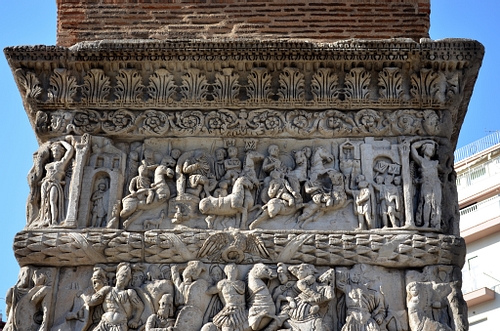
The triumphal arch, known today as the Kamara, was built c. 305 CE and still stands as an important city landmark. Originally with eight gates and topped by a dome, today only the large central gate (9.7 metres wide) and one secondary gate (4.85 metres wide) survive. There are relief carvings on its marble pillars which depict scenes from Galerius' military escapades against the Persians. The pillars are joined by a slender brick archway and would have originally had niches with statues above them.
